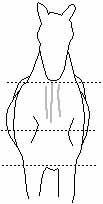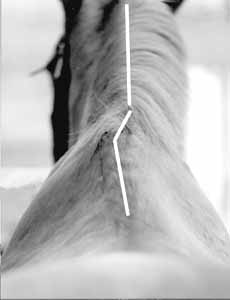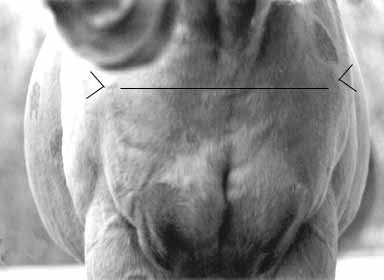
Identifying Asymmetry How do you identify a horse’s asymmetry? Stand your horse up square, not parked, and have someone hold him while you make your inspection. He should stand with his head and neck straight, with ‘a leg in each corner’, and with his weight on all four feet (many asymmetrical horses do not volunteer a square stance.). Stand behind him and examine his hips. Take a good look. You may wish to place a colored sticker on each hip to help you spot uneven development. Is he equally well developed, equally round, on both sides of his hindquarters? Absolutely do nitpick…subtle differences count. Is one hip higher or rounder than the other? Are the two points of his croup equal in height? Is his tail centered or does he carry it even slightly to one side?
Move the tail so you can see the back of the hind legs. Do the upper hind legs join the hocks at the same angle in both legs? How about the angle of his hind cannons? Are his hind feet turned out equally? Are the muscles on the insides of the hind legs developed the same in both legs? Are the points of his buttocks, just below the top of his tail, the same height? Is one more prominent than the other? If your horse will permit it, stand on something behind him and reach around his quarters to place a finger on each point of hip. Is one further forward than the other? Higher than the other? Now look along his back towards his withers. If necessary, stand on something so you get a good view. Does his spine lie in a straight line from the tail all the way to the ears? Or does it have a curve in it in one or more places? Is the loin area equally well developed on both sides of the spine?
Now focus on the withers area. Are they in line with the straight spine? Do they lean even slightly to one side? Is the top of the shoulder on one side more prominent than the other? Is there more of a hollow behind one shoulderblade than the other? Is there a curve in the crest of the neck? Does the mane flip over part-way up the neck? More than once? Are the ears level? Now move to your horse’s shoulder, and with him still standing square, locate the front edge of the scapula (shoulder blade). Run your finger up this edge, and at the top continue the movement in a straight line to the crest of his neck. Mark with chalk or have a friend leave a finger at this exact location on the crest while you move to the other side of the horse, and repeat the process there. Do the lines meet at the top of the crest, or is one further forward than the other? Now crouch down directly in front of your horse. He should still be standing square over his feet. Examine the area just above the front of the shoulder-blade, where the neck ties in. Is this more developed on one side? Look at his chest and locate the points of the shoulder at the lower end of the scapula (see photo below); palpate to find them if necessary and put a fingertip on each. Are they exactly the same height? Is one further forward than the other? Is one more prominent than the other? Look at the chest between his front legs. Is the lower edge straight across, or is one side lower? Look at his barrel. Can you see more of it on one side of the horse than on the other?
Now look at his front feet. Is one more upright than the other? Is one wider than the other? Does one turn in or out more than the other? Are the hooves balanced from side to side, or do they look as if they’re leaning to one side? (To help assess hoof balance, click here to go to Hoof Balance article.) These are just some of the more obvious and easiest places to look for asymmetry, and even here the symptoms may be subtle. And if asymmetry shows up at all in any of these places, the horse’s balance is affected, and this will negatively influence performance. Some horses show these effects more than others. In general the bulkier-muscled, and to some extent less sensitive, horses will tend to tolerate the effects better, and they may show the effects in a slight balkiness, if at all. However, they are still being stressed. | Riding Theory Main Page | Asymmetry | Identifying Asymmetry | Asymmetry and Performance | Asymmetry and Saddlefit | Asymmetry and Riding | What to do about asymmetry | Email : rafalet2ride@yahoo.ca | Home | Lusitanos | Equine
Biomechanics & Riding Theory
| Last updated July 6, 1999 All rights reserved |



